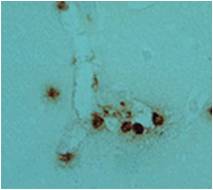Ximbio's Anti-Neutrophil elastase clone NP57 was cited in a recent mBio paper authored by multiple groups lead by Kami Kim at Albert Einstein College of Medicine. This publication studied groups of Malawi children co-infected with cerebral malaria and HIV. The study found that cerebral malaria-attributed mortality was higher in HIV-positive children than in HIV-negative children. They concluded that HIV is a risk factor for cerebral malaria and for death from cerebral malaria, independent of traditional measures of HIV disease severity.

Immunohistochemistry of brain tissue for neutrophils. Micrographs (x400) of brain section labelled for neutrophil elastase (NP57). Brown colour indicates the presence of neutrophil elastase. (Hochman et al. 2015. MBio. 6(5)).
Anti-Neutrophil elastase was used in this publication in immunohistochemical analysis, however it has been shown to have application in western blot, immunoprecipitation and immunofluorescence. Furthermore NP57 is useful for the differential diagnosis of acute leukaemia by APAAP labeling of cell smears. It may also be of value for the histopathological diagnosis of tumour deposits in myeloid leukaemia and for the detection of neutrophils in paraffin sections.
Clone NP57 was developed by Dr Karen Pulford at the University of Oxford. One of Dr Pulford's research interests is the study of lymphoma-associated antigens for their utility not only as a diagnostic or prognostic but also for their potential as immunotherapeutic targets.
HAVE YOU REGISTERED?
Join the ever-growing global Ximbio community. Register and receive updates about new reagents, institutes and new features being added to the website.
